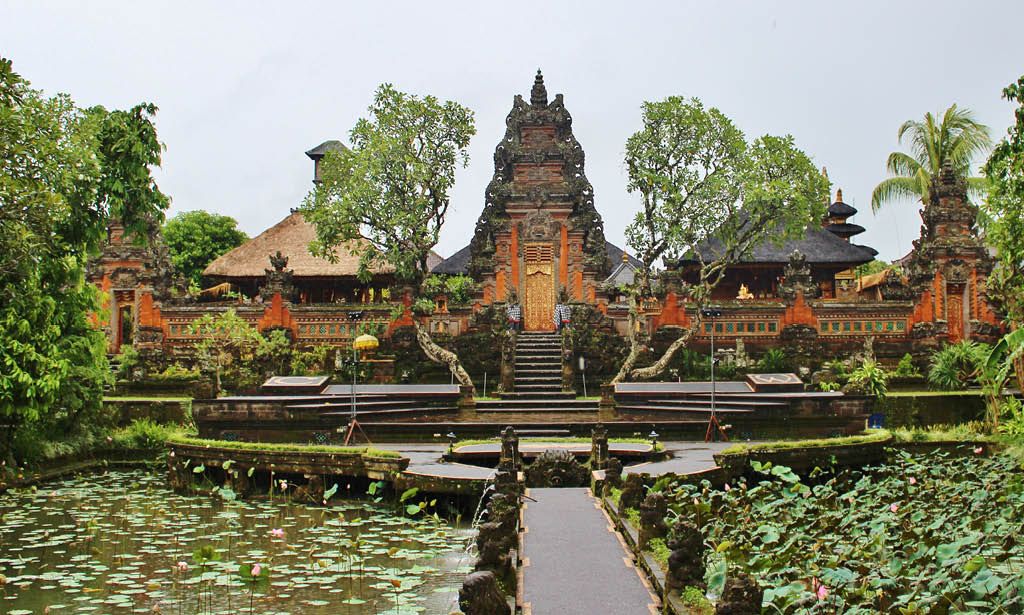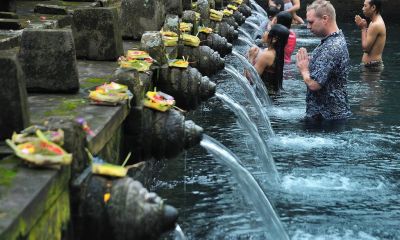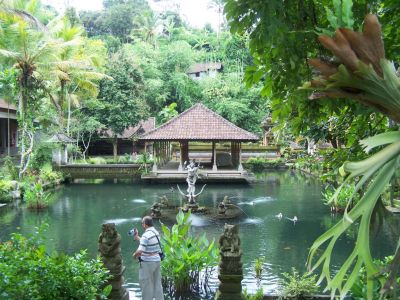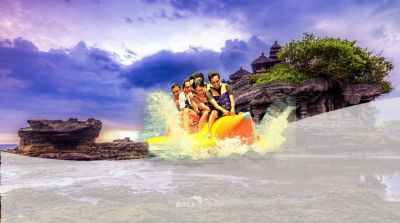Deskripsi
Puri Saren Ubud atau lebih dikenal sebagai Puri Kerajaan Bali Ubud adalah Istana Kerajaan Ubud dengan rumah-rumah tradisional Bali yang indah sebagai kediaman Raja Ubud. Terletak di pusat Ubud Bali dengan pasar seni tradisional tepat di depannya dan ditemukan oleh Ida Tjokorda Putu Kandel yang memerintah dari tahun 1800 - 1823. Puri Kerajaan Ubud adalah pusat kehidupan seni budaya artistik, sementara pasar tradisional adalah simbol ekonomi lokal penduduk. Keberadaan Puri Kerajaan Ubud sebagai istana dilengkapi dengan Wantilan/auditorium yang merupakan bangunan besar ruang rapat dan pohon beringin sebagai tempat berteduh pada siang hari. Pasar tradisional adalah tempat ekonomi masyarakat dan keberadaannya selalu berdekatan dengan istana sebagai pusat kehidupan seni budaya artistik. Ini berarti pertemuan kedua kutub menggambarkan dinamika kehidupan masyarakat dan kerajaan.
Sejarah keluarga kerajaan Bali bermula sejak abad ke-10 namun baru pada abad ke-14 mereka menjadi terkenal secara historis. Pada tahun 1343, Kekaisaran Majapahit menguasai setelah raja Jawa mengalahkan raja Bali. Pemerintahan mereka menandai kedatangan budaya Hindu Jawa, yang masih terlihat hingga hari ini dalam arsitektur, seni, literatur, tari, dan teater.
Beberapa desa Bali tetap terisolasi dari perubahan ini, namun, dengan berkembangnya Islam di seluruh Indonesia, Kekaisaran Majapahit akhirnya runtuh dan Bali menjadi merdeka pada akhir abad ke-15. Banyak bangsawan Jawa dan anggota kunci masyarakat kreatif mencari perlindungan di pulau tersebut dan periode itu dikenal sebagai Zaman Emas Bali.
Ubud telah menjadi "kota kerajaan" selama lebih dari seratus tahun. Para pangeran mereka, yang memiliki gelar "Tjokorda" atau "Agung" masih tinggal di istana tradisional, yang disebut "Puris". Namun perlu diketahui bahwa setiap tempat yang disebut "puri" bukanlah istana kerajaan. Kata tersebut telah digunakan dengan semakin liberal belakangan ini. Perlu juga diketahui bahwa tidak ada satu istana di Ubud, namun banyak, kebanyakan dari mereka berkumpul di sekitar persimpangan utama dekat pasar Bud. Ada beberapa kota "kerajaan" lain di area Bud, dengan istana mereka sendiri, kebanyakan memiliki ikatan keluarga dekat dengan Tjokorda Bud. Hubungan timbal balik dijaga melalui pernikahan kebetulan maupun diatur di antara keturunan putra-putri pangeran di puri-puri Sayan, Pejeng, Singapadu, Peliatan, dan Payangan.
Meskipun sistem feodal Bali yang lama telah digantikan oleh pemerintah kolonial Belanda lebih dari delapan puluh tahun yang lalu, Tjokorda masih memegang peran khusus dalam masyarakat Ubud. Banyak peran kepemimpinan, baik sakral maupun sekuler, dipegang oleh Tjokorda. Mereka juga memainkan peran penting dalam komunitas bisnis lokal, lembaga seni, dan lingkaran profesional. Meskipun tidak ada kekuasaan formal yang secara otomatis diberikan kepada seseorang karena berasal dari puri, kerajaan Ubud masih memerintah dengan penuh hormat semata-mata berdasarkan keturunan mereka. Mereka juga mendapat penghormatan dari beberapa pihak berdasarkan kekayaan mereka yang cukup besar.
Istana kerajaan telah lama menjadi pemilik tanah terbesar di daerah tersebut. Mereka biasanya menunjukkan peran ini dengan cara yang lebih "pengelolaan", mengelola lahan pertanian padi yang luas untuk kepentingan masyarakat dan pura-pura. Namun, belakangan ini, dengan munculnya model kepemilikan tanah ala barat, banyak istana mengembangkan atau menjual kepemilikan tanah untuk meningkatkan kekayaan pribadi mereka--terkadang dengan cara mencolok. Di Bali pra-kolonial, istana merupakan pelindung utama seni, musik, tari, dan literatur. Istana-istana Ubud dengan sadar melanjutkan tradisi ini. Mereka bertindak sebagai penjaga budaya tradisional, dan mengembangkan upaya seni di seluruh area, yang memberikan manfaat bagi warga Ubud dan para pengunjung.
Tjokorda bukan lagi perwujudan fisik Negara, mereka hanya warga biasa, dengan kekhawatiran yang sama seperti warga biasa lainnya, ditambah beberapa kekhawatiran tambahan. Oleh karena itu, istana-istana Ubud pada dasarnya hanyalah rumah keluarga, dan tidak satupun telah diubah menjadi museum atau objek wisata publik. Meskipun beberapa dari mereka adalah contoh yang baik dari arsitektur tradisional, tidak satupun dari mereka "sejarah" dalam hal usia. Sebenarnya, kebanyakan cukup baru. Istana Ubud tertua terletak sedikit di sebelah timur Pura Dalem Ubud, di atas jalan utama. Kediaman itu roboh akibat gempa bumi pada awal abad ini, dan tidak ada yang tersisa kecuali tempat yang datar dengan jejak-jejak pondasi di sana-sini.
Catatan
Titik pertemuan atau tempat rencana perjalanan yang akan dukunjungi
Paket menginap terfavorite













0/5